Avoid foods high in saturated fat, ultra-processed foods, dairy, alcohol, refined carbs, and unripe bananas while taking Miralax. These foods can worsen constipation and make Miralax less effective at relieving symptoms. Drinking plenty of water and eating fiber-rich foods helps Miralax work better and faster.
Miralax is a popular over-the-counter laxative that helps relieve constipation by drawing water into the intestines to soften stool. While this medication is generally safe and effective, certain foods and drinks can interfere with its ability to work properly or make side effects worse.
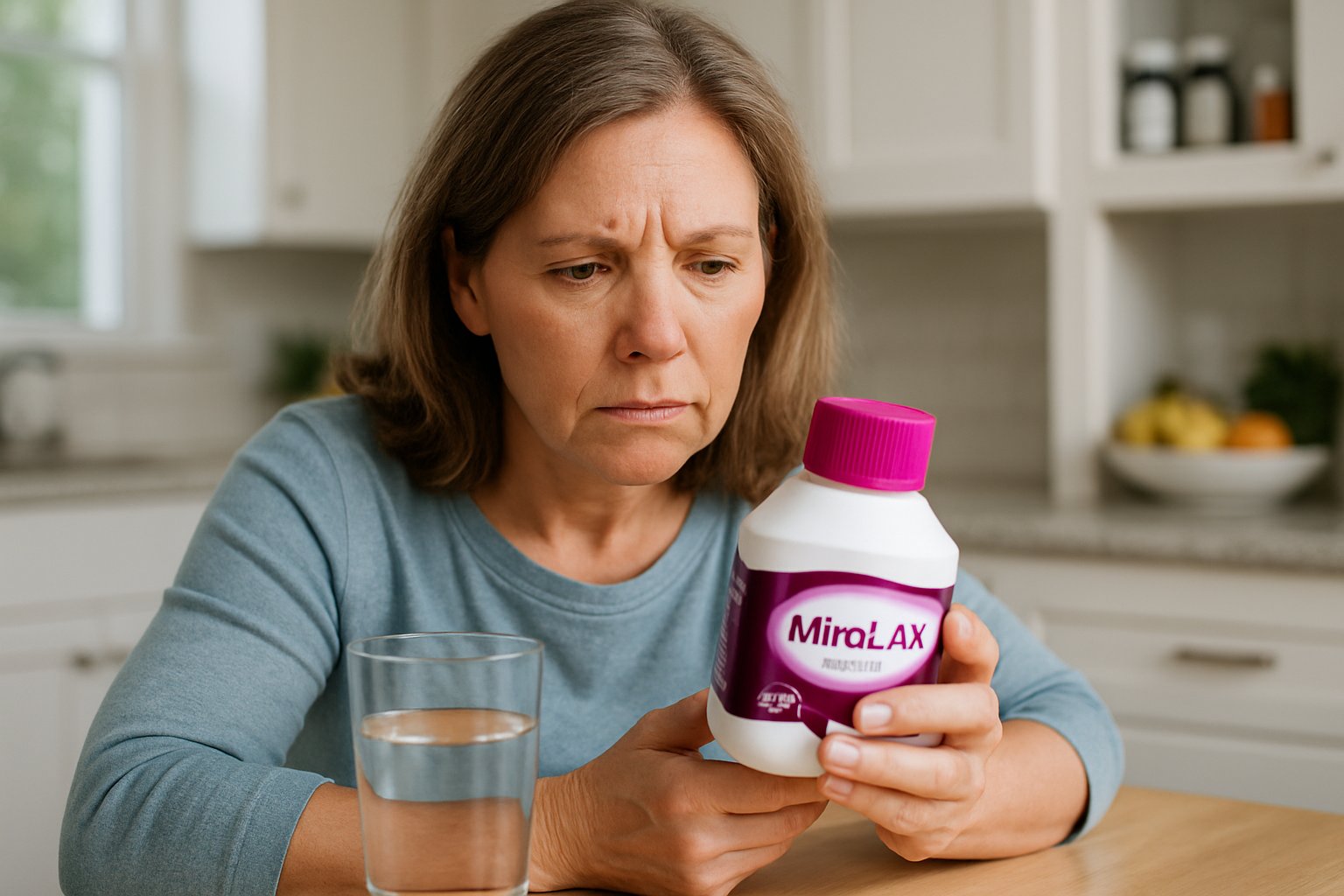
The most important foods to avoid while taking Miralax include high-saturated fat foods, ultra-processed items, dairy products, alcohol, refined carbohydrates, and unripe bananas because these can worsen constipation and make the medication less effective. Understanding which foods can reduce MiraLax effectiveness[1] helps people get better results from their treatment.
Making smart dietary choices while taking Miralax can mean the difference between quick relief and continued discomfort. The good news is that no foods directly interact with the medication, but avoiding constipation-causing foods helps Miralax do its job more effectively.
Understanding How Miralax Works
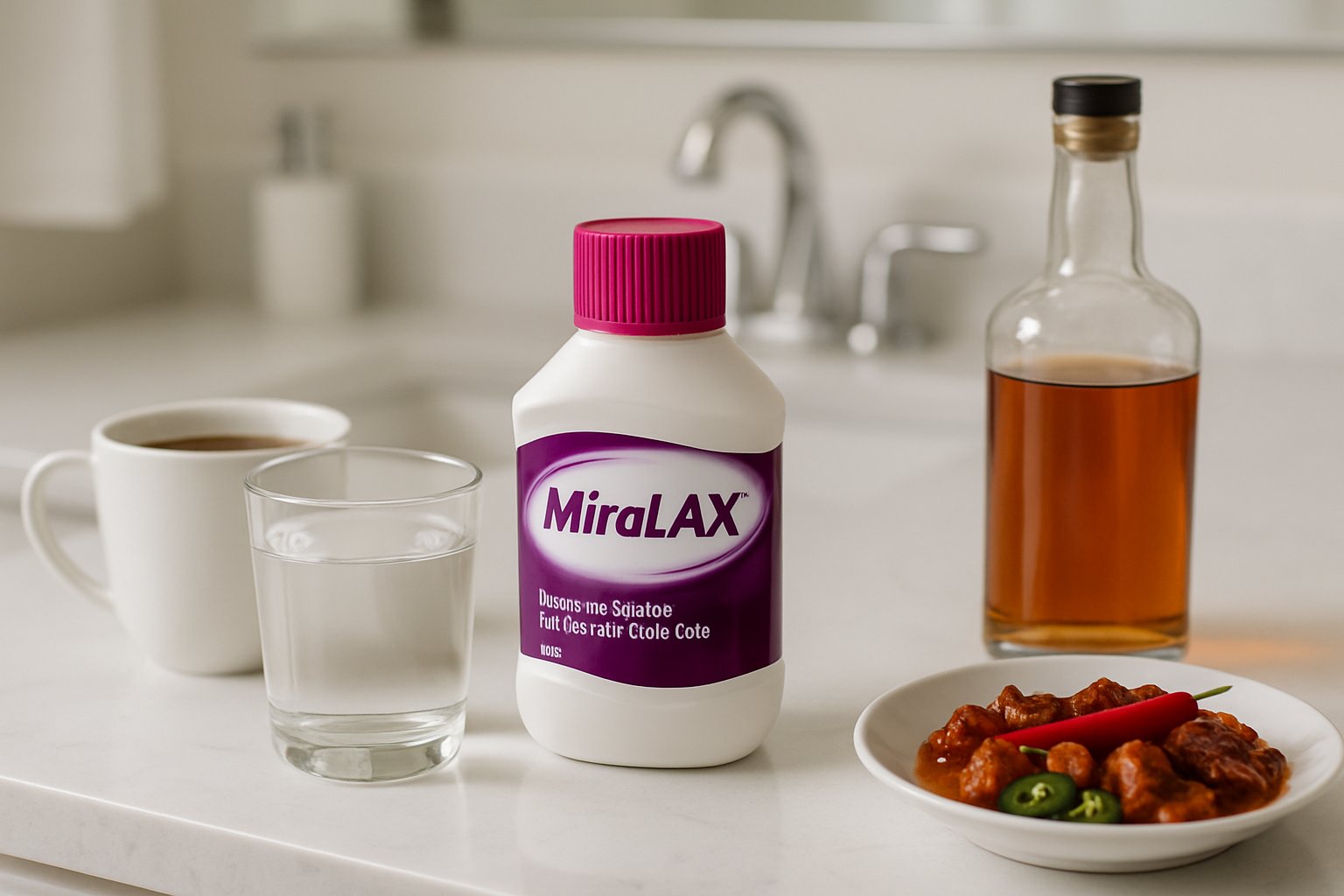
Miralax contains polyethylene glycol 3350, which draws water into the intestines to soften stool and promote bowel movements. This gentle osmotic process requires adequate hydration to work effectively and typically produces results within one to three days.
Osmotic Laxative Mechanism
Miralax functions as an osmotic laxative[1] by preventing water reabsorption in the intestines. The medication creates a concentration gradient that pulls water from surrounding tissues into the bowel.
This water retention makes stool softer and easier to pass. Unlike stimulant laxatives, Miralax doesn’t force muscle contractions in the digestive tract.
The osmotic action happens gradually over 24 to 72 hours. Patients typically experience increased bowel movements without cramping or urgency.
Key benefits of osmotic action:
- Gentle on the digestive system
- Predictable results
- Minimal side effects
- No dependency risk with short-term use
Why Hydration Matters
Proper hydration is essential for Miralax to work effectively. The medication relies on available water in the body to create its osmotic effect.
Dehydration can reduce the medication’s effectiveness. When the body lacks sufficient fluid, there’s less water available to draw into the intestines.
Patients should drink plenty of fluids while taking Miralax. Water, clear broths, and hydrating foods support the medication’s action.
Hydration requirements include:
- 4-8 ounces of water with each dose
- Continued fluid intake throughout the day
- Foods with high water content like watermelon and cucumber
- Avoiding alcohol, which causes dehydration
Role of Polyethylene Glycol 3350
Polyethylene glycol 3350 (PEG 3350) serves as Miralax’s active ingredient. This synthetic polymer molecule is too large for the body to absorb through intestinal walls.
PEG 3350 remains in the digestive tract and acts like a sponge. It binds to water molecules and prevents their reabsorption back into the body.
The medication doesn’t require digestion or absorption to work. This characteristic makes it safe for most people and reduces drug interactions.
PEG 3350 properties:
- Molecular weight of 3350 daltons
- Not metabolized by the body
- Eliminated unchanged in stool
- No significant absorption into bloodstream
Clinical studies show PEG 3350 effectively treats occasional constipation in adults. The FDA has approved this ingredient for over-the-counter use in laxative products.
Foods and Drinks That Can Reduce Miralax Effectiveness
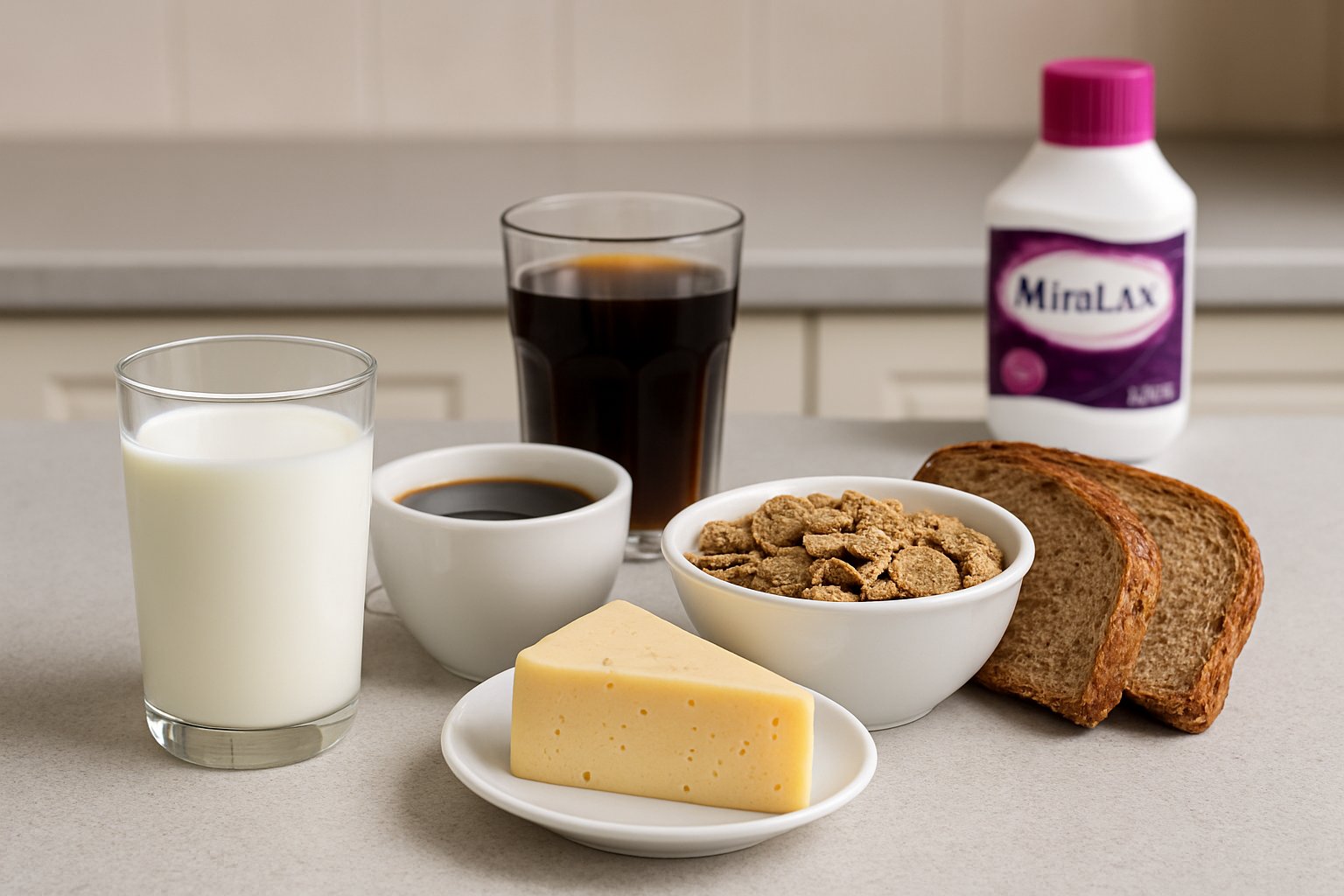
Certain foods and drinks can make it harder for Miralax to work properly by causing constipation or slowing digestion. Foods high in saturated fat, ultra-processed items, and sugary beverages[1] can work against the medication’s ability to soften stool and promote bowel movements.
High-Fat Foods and Fried Foods
Foods with high saturated fat content slow down the digestive system. This makes it much harder for Miralax to do its job effectively.
Common high-fat foods to limit include:
- Red meat
- Fried chicken and fish
- Butter and coconut oil
- Full-fat dairy products
- Deep-fried snacks
Research shows that diets high in saturated fat are linked to having fewer than three bowel movements per week[1]. The risk is even higher for people over 65 and those with diabetes.
Fried foods are particularly problematic. They contain both saturated fats and are often hard to digest.
The combination of these factors can counteract Miralax’s ability to draw water into the intestines. This leaves patients with harder stools that are difficult to pass.
Sugary Foods and Beverages
High-sugar foods and drinks can contribute to constipation by affecting digestion and stool consistency. Added sugars are especially problematic when taken in large amounts.
Foods and drinks to avoid include:
- Candy and chocolates
- Cookies and pastries
- Ice cream
- Soda and sweetened beverages
- Energy drinks
Sugar can make stools harder and more difficult to pass. This works directly against what Miralax is trying to accomplish.
Coffee and tea present a special case. While both contain caffeine that can have a mild diuretic effect, coffee often helps with bowel movements. Tea is generally neutral for most people.
However, adding excessive sugar to these drinks can negate any potential benefits. Patients should drink coffee and tea with minimal added sweeteners.
Processed and Fast Foods
Processed and fast foods contain high levels of sodium, unhealthy fats, and additives that can worsen constipation. These foods are designed for convenience but work against digestive health.
Problematic processed foods include:
- Instant noodles
- Potato chips
- Pepperoni and processed meats
- Frozen meals
- Fast food burgers and fries
Sodium is a major concern in these foods. High sodium intake increases constipation risk by affecting both stool frequency and consistency.
Fast food combines multiple problems. It typically contains saturated fats, excess sodium, and refined ingredients.
Alcohol also fits into this category of items to limit. It has a dehydrating effect that can make stools firmer and harder to pass. The more alcohol consumed, the higher the constipation risk becomes.
These foods essentially work against Miralax by creating the exact conditions the medication is meant to treat.
Dietary Items That May Worsen Side Effects
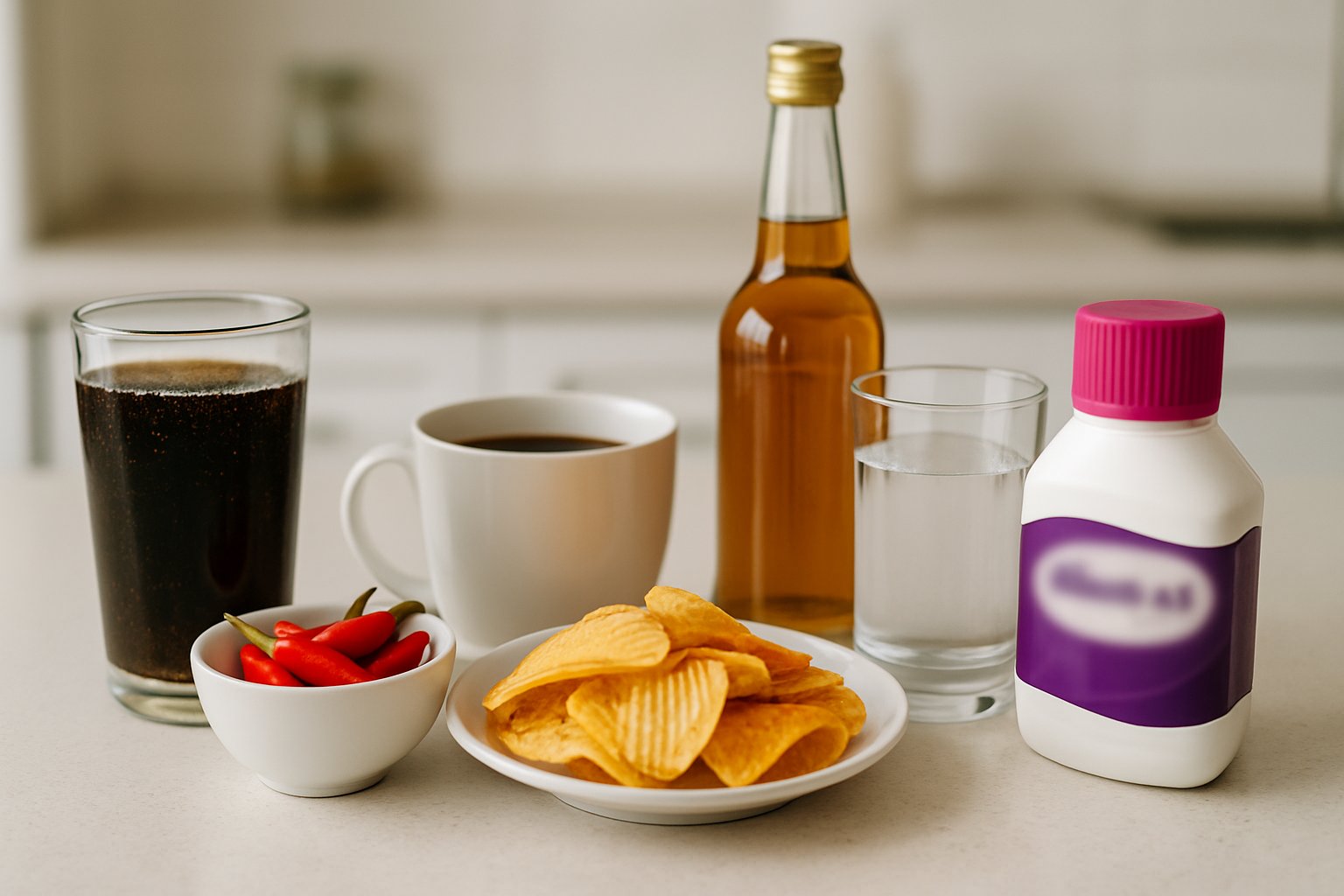
Some foods and drinks can make Miralax side effects like bloating, cramping, and gas feel worse. High-sodium foods can increase constipation risk[2], while dairy products may cause digestive upset in sensitive individuals, and excessive caffeine can lead to dehydration.
Dairy and Lactose Intolerance
Full-fat dairy contains saturated fat, which can trigger constipation[2] in some people. This makes it harder for Miralax to work effectively.
People with lactose intolerance may experience additional digestive problems when combining dairy products with Miralax. About 30% of lactose intolerant individuals experience constipation instead of typical symptoms like diarrhea.
Common dairy products that may cause issues:
- Whole milk
- Cheese
- Ice cream
- Butter
- Full-fat yogurt
Lactose intolerance can worsen bloating and cramping that sometimes occurs with Miralax. These symptoms happen because the body cannot properly break down lactose, the sugar found in milk products.
People taking Miralax should consider limiting or avoiding dairy products if they notice increased digestive discomfort. Low-fat or lactose-free alternatives may be better options during treatment.
High-Sodium Foods
Foods with high sodium levels can make constipation worse[2] and reduce Miralax effectiveness. Sodium draws water away from the intestines, making stools harder and more difficult to pass.
High-sodium foods to limit:
- Processed meats
- Canned soups
- Frozen dinners
- Potato chips
- Restaurant meals
Research shows that high sodium intake increases constipation risk in two ways. It affects both stool frequency and consistency, making bowel movements less regular and more difficult.
Ultra-processed foods often contain excessive sodium along with unhealthy fats and added sugars. These ingredients work together to slow digestion and worsen constipation symptoms.
Reading food labels helps identify hidden sodium sources. Foods with more than 400mg of sodium per serving are considered high-sodium options that may interfere with Miralax.
Excessive Caffeine
Moderate caffeine intake from coffee or tea usually does not interfere with Miralax. However, excessive amounts can cause dehydration, which makes constipation worse.
Caffeine acts as a diuretic, increasing urination and fluid loss. Since Miralax works by drawing water into the intestines, dehydration reduces its effectiveness.
Caffeinated beverages to monitor:
- Energy drinks
- Multiple cups of coffee
- Strong black tea
- Caffeinated sodas
People with sensitive stomachs may experience increased cramping when combining caffeinated beverages with Miralax. The stimulating effects of caffeine can amplify digestive discomfort.
Coffee often has natural laxative effects that may actually help with constipation. However, drinking too much can lead to loose stools or diarrhea when combined with Miralax.
Staying hydrated with water remains more important than limiting moderate caffeine intake. Most people can continue drinking 1-2 cups of coffee or tea daily while taking Miralax without problems.
Potential Side Effects and Warning Signs
MiraLAX can cause digestive reactions like bloating, gas, and cramping in some users. Dehydration becomes a concern when diarrhea or frequent bowel movements occur, while allergic reactions require immediate medical attention.
Common Digestive Reactions
The most frequent side effects involve the digestive system. Common side effects include diarrhea, nausea, stomach cramps, and gas[3].
Bloating and abdominal pain affect many users. These symptoms typically occur within hours of taking the medication.
Gas and flatulence are normal responses as the medication works. The polyethylene glycol draws water into the intestines, which can create these digestive reactions.
Common digestive side effects:
- Bloating
- Gas and flatulence
- Abdominal cramping
- Nausea
- Mild stomach discomfort
Frequent bowel movements may continue for several hours after taking MiraLAX. This is the intended effect but can become uncomfortable.
Users should expect softer stools and possible urgency. These effects usually resolve within 24 hours of taking the medication.
Dehydration Risks
Diarrhea and frequent bowel movements can lead to fluid loss. The body loses water and electrolytes when bowel movements become excessive.
Drinking plenty of water while taking this medication helps decrease constipation[4] and prevents dehydration. Users should increase their fluid intake before and after taking MiraLAX.
Signs of dehydration include:
- Dry mouth
- Dizziness
- Dark yellow urine
- Fatigue
- Decreased urination
Severe diarrhea lasting more than a day requires medical attention. Users should monitor their fluid intake and watch for dehydration symptoms.
Older adults face higher dehydration risks. They should be especially careful about maintaining adequate fluid levels.
Signs of Allergic Reaction
Allergic reactions[5] to MiraLAX are uncommon but can be serious. Users should recognize the warning signs and seek immediate help when needed.
Skin reactions appear first in many cases. Hives, rash, or itching may develop shortly after taking the medication.
Emergency symptoms requiring immediate medical care:
- Difficulty breathing
- Swelling of face, lips, or throat
- Severe rash or hives
- Rapid heartbeat
- Severe dizziness
Mild skin irritation around the anal area can occur from frequent bowel movements. This differs from a true allergic reaction to the medication itself.
Users experiencing any breathing problems or facial swelling should call emergency services. These symptoms indicate a potentially life-threatening reaction that needs immediate treatment.
Recommended Foods and Lifestyle Habits
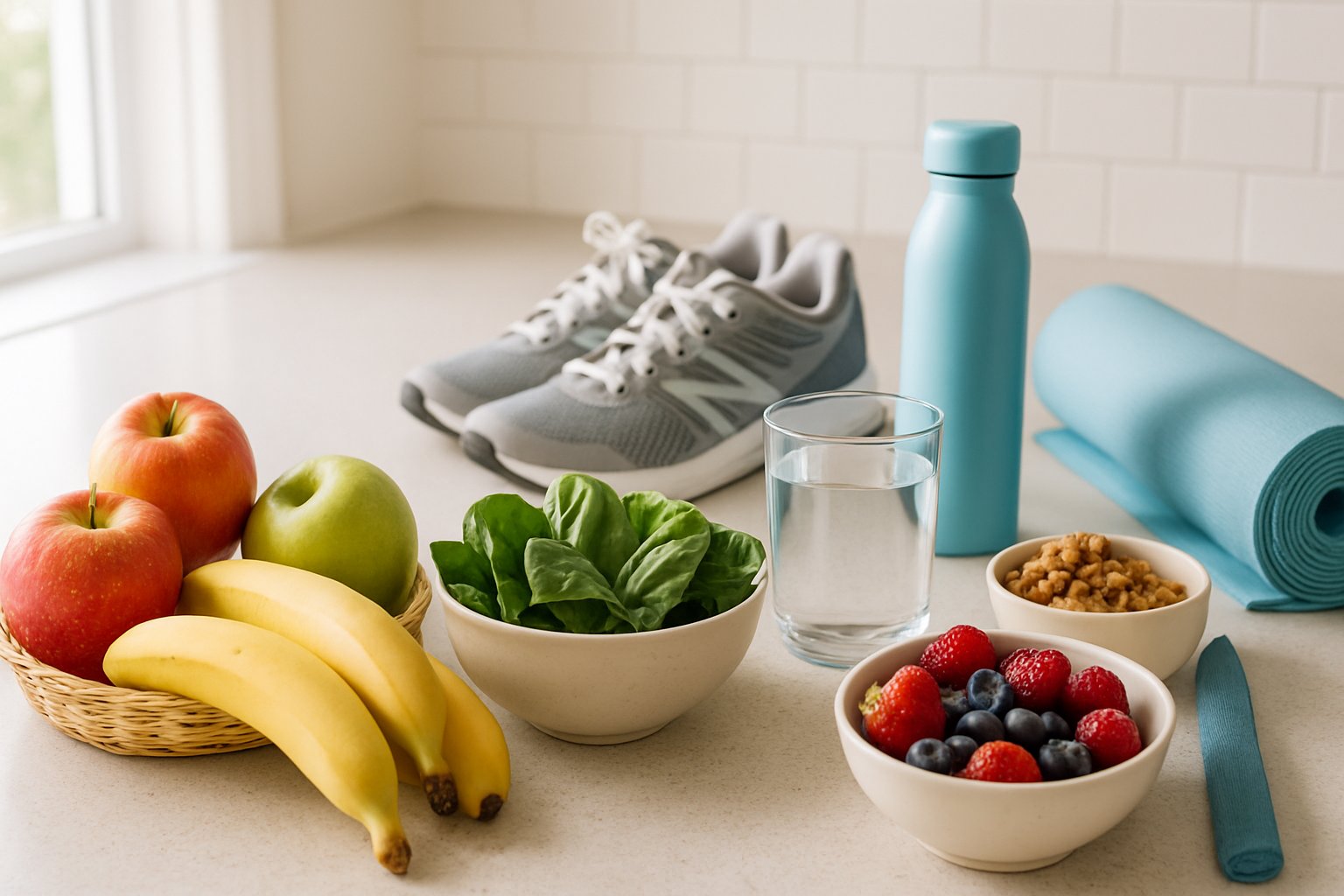
The right foods and habits can help Miralax work more effectively and promote better digestive health. Proper hydration, high-fiber foods, and regular physical activity all support healthy bowel movements.
Hydration Strategies
Water plays a crucial role in how Miralax functions in the body. The medication works by drawing water into the intestines to soften stool.
Drinking 4-8 ounces of water with each Miralax dose helps the medication dissolve properly. People should continue drinking water throughout the day to maintain proper hydration levels.
Foods with high water content[1] can provide additional hydration benefits. These include:
- Watermelon (92% water)
- Cucumber (96% water)
- Lettuce (95% water)
- Celery (95% water)
Clear soups and broths also contribute to daily fluid intake. Herbal teas without caffeine can help people meet their hydration goals.
Dehydration makes constipation worse and reduces Miralax’s effectiveness. Most adults need 8-10 glasses of water daily when taking laxatives.
Increasing Dietary Fiber
Fiber helps create softer, bulkier stools that move more easily through the digestive system. Two types of fiber benefit bowel health differently.
Soluble fiber dissolves in water and forms a gel-like substance. It helps soften stool and feeds beneficial gut bacteria. Good sources include:
- Apples with skin
- Pears with skin
- Beans and legumes
- Oats and barley
Insoluble fiber adds bulk to stool and helps it move through the intestines faster. It comes from:
- Whole grains like brown rice
- Bran cereals
- Broccoli and leafy greens
- Plums and dried fruits
Adults should aim for 25-35 grams of fiber daily. People taking Miralax should increase fiber intake gradually to avoid gas and bloating.
High-fiber foods work well with Miralax[1] because they support the medication’s stool-softening effects. Combining both approaches often produces better results than either method alone.
Physical Activity and Bowel Health
Regular movement helps stimulate the muscles in the digestive tract. Physical activity encourages natural bowel contractions that move stool through the intestines.
Even light exercise can improve digestive health. Walking for 20-30 minutes daily helps many people maintain regular bowel movements.
Beneficial activities include:
- Walking after meals
- Gentle yoga poses
- Swimming
- Stretching exercises
Exercise works best when combined with proper hydration and fiber intake. The combination helps Miralax work more effectively and reduces the time needed for results.
People with limited mobility can still benefit from seated exercises or gentle stretching. Any increase in physical activity can support better digestive health and bowel function.
Special Considerations and Professional Guidance
Miralax dosage adjustments and medical supervision become necessary for certain health conditions and individual circumstances. Professional guidance helps ensure safe use and prevents potential complications.
Adjusting Dosage Safely
The standard Miralax dose is one capful (17 grams) mixed in 8 ounces of liquid once daily. However, some individuals may need different amounts based on their response and medical history.
Starting doses should be conservative. Many people begin with half the recommended dose to assess tolerance. This approach helps prevent cramping or loose stools that can occur with full-strength dosing.
Maximum daily limits exist for safety reasons. Adults should not exceed 34 grams (two capfuls) in a 24-hour period without medical supervision. Higher doses increase the risk of electrolyte imbalances and dehydration.
People taking other medications should space Miralax doses appropriately. A two-hour gap between Miralax and other drugs prevents absorption issues.
Duration matters as much as dosage. Use beyond seven consecutive days requires medical evaluation to rule out underlying conditions causing chronic constipation.
Consulting a Registered Dietitian
A registered dietitian provides valuable guidance for people experiencing recurring constipation while using Miralax. They assess dietary patterns that may interfere with the medication’s effectiveness.
Fiber intake requires professional balancing. Too little fiber worsens constipation, while excessive amounts can cause bloating and gas. A dietitian calculates optimal fiber levels based on individual needs.
Hydration strategies need customization. People with kidney disease, heart conditions, or fluid restrictions require specialized hydration plans when taking Miralax.
Dietitians identify foods that can worsen constipation[1] and interfere with treatment success. They create meal plans that support digestive health and medication effectiveness.
Food timing affects Miralax absorption. Professional guidance helps coordinate meals and medication doses for optimal results.
Conditions That Require Medical Advice
Certain medical conditions make Miralax use more complex and require physician oversight before starting treatment.
Irritable bowel syndrome patients need careful monitoring. IBS symptoms can worsen with improper laxative use. Doctors evaluate whether Miralax suits the specific IBS subtype.
People with kidney disease face electrolyte risks when using any laxative. Medical supervision ensures safe use without disrupting mineral balance.
Heart conditions affect fluid management. Patients taking heart medications or managing fluid retention need medical clearance before using Miralax regularly.
Individuals currently using stimulant laxatives require medical guidance to transition safely. Abrupt changes between laxative types can worsen constipation or cause dependency issues.
Occasional constipation versus chronic problems requires different approaches. Doctors determine whether Miralax addresses the root cause or merely masks underlying digestive disorders.
Pregnant and breastfeeding women should consult healthcare providers before using Miralax, even though it’s generally considered safe during these periods.
Frequently Asked Questions
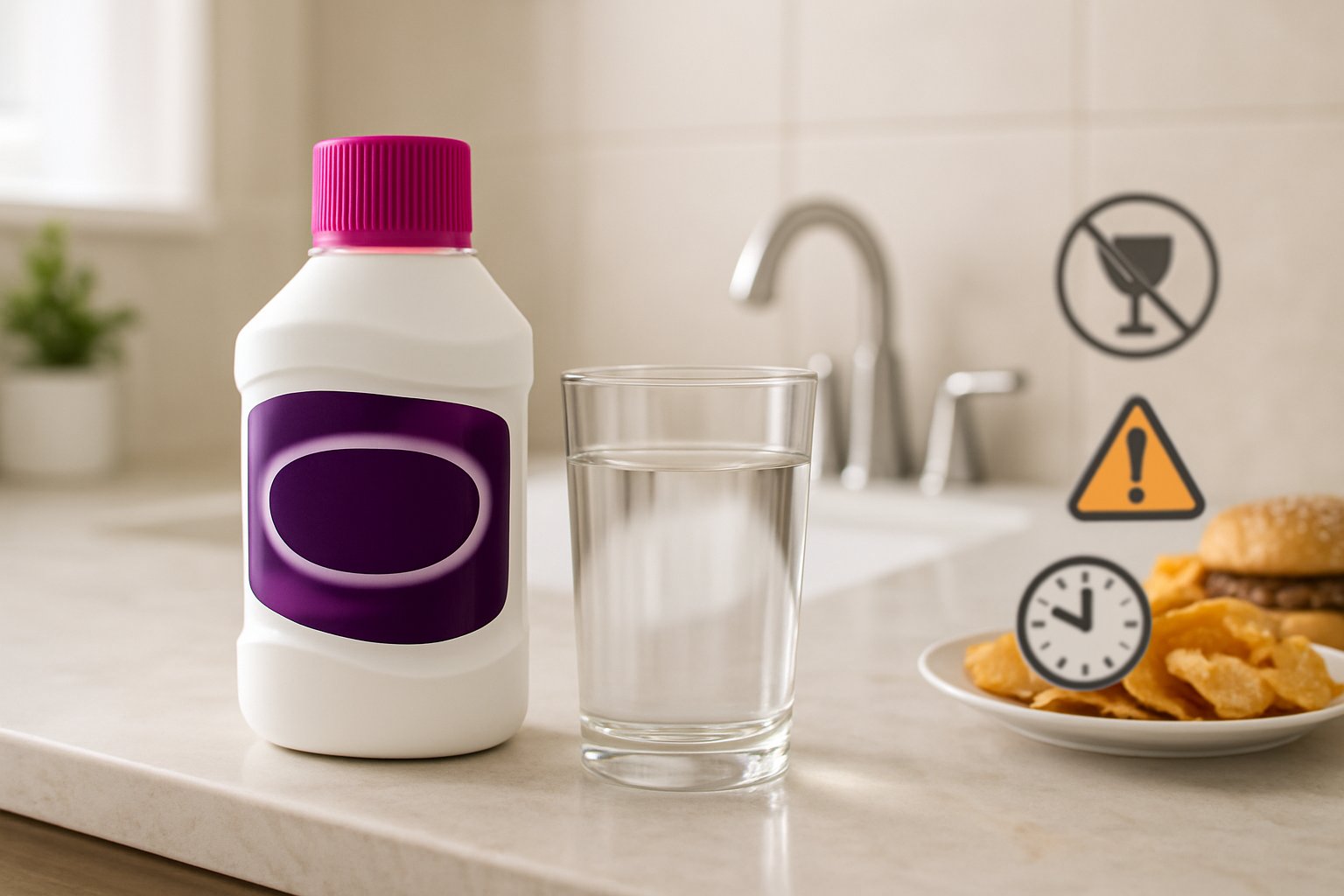
People often have concerns about drug interactions, dietary restrictions, and safe usage periods when taking MiraLAX. Understanding potential risks for elderly users and daily use guidelines helps ensure safe and effective treatment.
What interactions should one be aware of when using MiraLAX?
MiraLAX has minimal drug interactions because it stays mostly in the digestive system. However, it can affect how the body absorbs other medications.
People should take other medications at least two hours before or after MiraLAX. This prevents the laxative from interfering with drug absorption.
Patients taking blood thinners, heart medications, or seizure drugs should talk to their doctor first. These medications need consistent absorption levels to work properly.
Are there any specific foods or beverages to avoid while taking MiraLAX?
Certain foods can worsen MiraLax side effects[1] like bloating and stomach cramps. High-fat foods slow digestion and may reduce the medication’s effectiveness.
Processed foods, fried items, and dairy products can increase constipation. These foods work against what MiraLAX is trying to accomplish.
Alcohol should be limited because it causes dehydration. MiraLAX needs adequate fluid intake to work properly.
Caffeine in large amounts can also lead to dehydration. People should drink plenty of water throughout the day when using this medication.
Is there a recommended duration for MiraLAX use to prevent long-term side effects?
Most doctors recommend using MiraLAX for no more than seven days without medical supervision. Short-term use reduces the risk of developing dependency or electrolyte imbalances.
People who need longer treatment should work with their healthcare provider. A doctor can monitor for potential complications and adjust the treatment plan.
Some patients may need MiraLAX for chronic conditions under medical guidance. Regular check-ups help ensure safe long-term use.
What are the potential risks of using MiraLAX for an extended period?
Long-term MiraLAX use can cause electrolyte imbalances. The body may lose important minerals like sodium and potassium.
Extended use might lead to bowel dependency. The intestines may become less able to move waste naturally without the medication.
Chronic diarrhea from overuse can cause dehydration and nutrient deficiencies. This is especially concerning for older adults and people with other health conditions.
Some people may develop tolerance, requiring higher doses for the same effect. This increases the risk of side effects.
Can the use of MiraLAX lead to complications in elderly patients?
Elderly patients face higher risks when using MiraLAX regularly. Age-related changes in kidney function make electrolyte imbalances more dangerous.
Older adults are more prone to dehydration. They may not recognize thirst signals or have difficulty drinking enough fluids.
Seniors taking multiple medications have increased interaction risks. MiraLAX can affect how other drugs are absorbed in the digestive system.
Falls and confusion can result from electrolyte imbalances in elderly users. These complications can be serious and require immediate medical attention.
Is it safe to take MiraLAX daily, and for how long?
Daily MiraLAX use should only occur under medical supervision. Most healthcare providers limit unsupervised use to one week or less.
Some people with chronic constipation may need daily doses for longer periods. This requires regular monitoring by a healthcare professional.
Patients should start with the lowest effective dose when using MiraLAX daily. Higher doses increase the risk of side effects and complications.
Regular blood tests may be needed for long-term daily users. These tests check for electrolyte imbalances and kidney function changes.
References
- 6 foods to avoid while taking MiraLax. https://www.singlecare.com/blog/foods-to-avoid-while-taking-miralax/ Accessed October 24, 2025
- HMN: 6 foods to avoid while taking MiraLax in 2025 – Consumer Review. https://healthmedicinet.com/review/hmn-6-foods-to-avoid-while-taking-miralax-in-2025/ Accessed October 24, 2025
- Side Effects of Miralax (polyethylene glycol): Interactions & Warnings. https://www.medicinenet.com/side_effects_of_miralax_polyethylene_glycol/side-effects.htm Accessed October 24, 2025
- Polyethylene Glycol Powder (MiraLax®): Uses & Side Effects. https://my.clevelandclinic.org/health/drugs/18795-polyethylene-glycol-powder-for-solution Accessed October 24, 2025
- MiraLAX Side Effects: Common, Severe, Long Term. https://www.drugs.com/sfx/miralax-side-effects.html Accessed October 24, 2025
